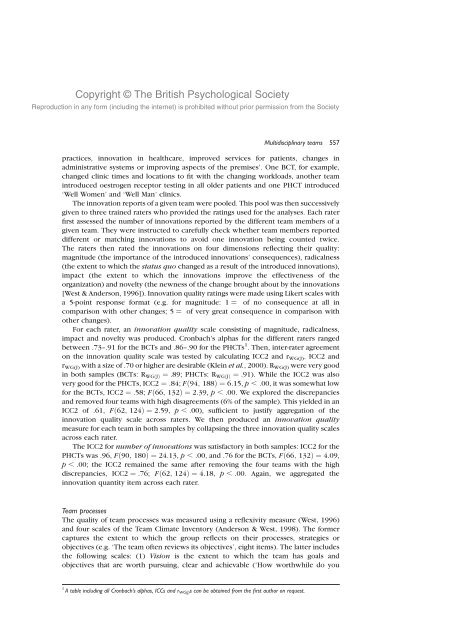Getting the most out of multidisciplinary teams: A multi-sample ... - IIMS
Getting the most out of multidisciplinary teams: A multi-sample ... - IIMS
Getting the most out of multidisciplinary teams: A multi-sample ... - IIMS
You also want an ePaper? Increase the reach of your titles
YUMPU automatically turns print PDFs into web optimized ePapers that Google loves.
Copyright © The British Psychological Society<br />
Reproduction in any form (including <strong>the</strong> internet) is prohibited with<strong>out</strong> prior permission from <strong>the</strong> Society<br />
Multidisciplinary <strong>teams</strong> 557<br />
practices, innovation in healthcare, improved services for patients, changes in<br />
administrative systems or improving aspects <strong>of</strong> <strong>the</strong> premises’. One BCT, for example,<br />
changed clinic times and locations to fit with <strong>the</strong> changing workloads, ano<strong>the</strong>r team<br />
introduced oestrogen receptor testing in all older patients and one PHCT introduced<br />
‘Well Women’ and ‘Well Man’ clinics.<br />
The innovation reports <strong>of</strong> a given team were pooled. This pool was <strong>the</strong>n successively<br />
given to three trained raters who provided <strong>the</strong> ratings used for <strong>the</strong> analyses. Each rater<br />
first assessed <strong>the</strong> number <strong>of</strong> innovations reported by <strong>the</strong> different team members <strong>of</strong> a<br />
given team. They were instructed to carefully check whe<strong>the</strong>r team members reported<br />
different or matching innovations to avoid one innovation being counted twice.<br />
The raters <strong>the</strong>n rated <strong>the</strong> innovations on four dimensions reflecting <strong>the</strong>ir quality:<br />
magnitude (<strong>the</strong> importance <strong>of</strong> <strong>the</strong> introduced innovations’ consequences), radicalness<br />
(<strong>the</strong> extent to which <strong>the</strong> status quo changed as a result <strong>of</strong> <strong>the</strong> introduced innovations),<br />
impact (<strong>the</strong> extent to which <strong>the</strong> innovations improve <strong>the</strong> effectiveness <strong>of</strong> <strong>the</strong><br />
organization) and novelty (<strong>the</strong> newness <strong>of</strong> <strong>the</strong> change brought ab<strong>out</strong> by <strong>the</strong> innovations<br />
[West & Anderson, 1996]). Innovation quality ratings were made using Likert scales with<br />
a 5-point response format (e.g. for magnitude: 1 ¼ <strong>of</strong> no consequence at all in<br />
comparison with o<strong>the</strong>r changes; 5 ¼ <strong>of</strong> very great consequence in comparison with<br />
o<strong>the</strong>r changes).<br />
For each rater, an innovation quality scale consisting <strong>of</strong> magnitude, radicalness,<br />
impact and novelty was produced. Cronbach’s alphas for <strong>the</strong> different raters ranged<br />
between .73–.91 for <strong>the</strong> BCTs and .86–.90 for <strong>the</strong> PHCTs 1 . Then, inter-rater agreement<br />
on <strong>the</strong> innovation quality scale was tested by calculating ICC2 and r WG(J) . ICC2 and<br />
r WG(J) with a size <strong>of</strong> .70 or higher are desirable (Klein et al., 2000). R WG(J) were very good<br />
in both <strong>sample</strong>s (BCTs: R WGðJÞ ¼ :89; PHCTs: R WGðJÞ ¼ :91). While <strong>the</strong> ICC2 was also<br />
very good for <strong>the</strong> PHCTs, ICC2 ¼ :84; Fð94; 188Þ ¼6:15, p , :00, it was somewhat low<br />
for <strong>the</strong> BCTs, ICC2 ¼ :58; Fð66; 132Þ ¼2:39, p , :00. We explored <strong>the</strong> discrepancies<br />
and removed four <strong>teams</strong> with high disagreements (6% <strong>of</strong> <strong>the</strong> <strong>sample</strong>). This yielded in an<br />
ICC2 <strong>of</strong> .61, Fð62; 124Þ ¼2:59, p , :00), sufficient to justify aggregation <strong>of</strong> <strong>the</strong><br />
innovation quality scale across raters. We <strong>the</strong>n produced an innovation quality<br />
measure for each team in both <strong>sample</strong>s by collapsing <strong>the</strong> three innovation quality scales<br />
across each rater.<br />
The ICC2 for number <strong>of</strong> innovations was satisfactory in both <strong>sample</strong>s: ICC2 for <strong>the</strong><br />
PHCTs was .96, Fð90; 180Þ ¼24:13, p , :00, and .76 for <strong>the</strong> BCTs, Fð66; 132Þ ¼4:09,<br />
p , :00; <strong>the</strong> ICC2 remained <strong>the</strong> same after removing <strong>the</strong> four <strong>teams</strong> with <strong>the</strong> high<br />
discrepancies, ICC2 ¼ :76; Fð62; 124Þ ¼4:18, p , :00. Again, we aggregated <strong>the</strong><br />
innovation quantity item across each rater.<br />
Team processes<br />
The quality <strong>of</strong> team processes was measured using a reflexivity measure (West, 1996)<br />
and four scales <strong>of</strong> <strong>the</strong> Team Climate Inventory (Anderson & West, 1998). The former<br />
captures <strong>the</strong> extent to which <strong>the</strong> group reflects on <strong>the</strong>ir processes, strategies or<br />
objectives (e.g. ‘The team <strong>of</strong>ten reviews its objectives’, eight items). The latter includes<br />
<strong>the</strong> following scales: (1) Vision is <strong>the</strong> extent to which <strong>the</strong> team has goals and<br />
objectives that are worth pursuing, clear and achievable (‘How worthwhile do you<br />
1 A table including all Cronbach’s alphas, ICCs and r WG(J) s can be obtained from <strong>the</strong> first author on request.










